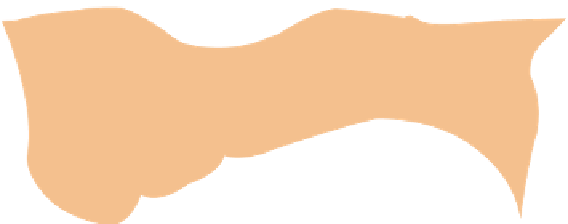Geoscience Reference
In-Depth Information
(a)
Figure 12.4
(a) Principal forms of igneous
intrusion and extrusion and (b)
modern annual rates of global
magma production.
Source: Partly after Smith (1982)
Eruptive products
MAIN VENT
Satellite cone
Plug
Lava flow
EXTRUSIVE
VOLCANIC
Ash layers
Dyke
Sill
INTRUSIVE
HYPABYSSAL
Feeder dyke
Sill complex
METAMORPHIC
AUREOLE
BATHOLITH
PLUTONIC
(b)
Extrusive magma
0.1 km
3
1.0 km
3
0.9 km
3
4 km
3
Intrusive magma
1.2 km
3
9.5 km
3
?
Island arc
Continental
Collision
Intra-plate
Mid-ocean ridge
14 km
3
CONSUMED
CRUST
Lithosphere
Asthenosphere
a solid, rhyolitic plug in the vent enhances explosivity and
may cause lateral blasts of the sort displayed by Mount St
Helens in 1980 (
Plate 12.2
and see
Plate 10.1
).
The violent exhalation of gases, magma and frag-
mented rock dramatically transforms volcanic products
from lava flows over surrounding landscapes into airborne
tephra, rained out over a large area. Fine ash is forced
several kilometres into the atmosphere as an
ash
column,
extending a
plume
and
ash fall
often thousands of
kilometres downwind. Column collapse of heavier ash,
lapilli
and tephra
bombs
on to the volcano develops into
fast-moving,
incandescent
(fiery) ash flows or
nuées
ardentes
at ground level (
Plate 12.3
).
Sedimentation from
the atmosphere and through water, from flows or plumes
extending seawards, forms
pyroclastic rocks
. Heat often
welds fine-grained
ash-fall tuffs
, even under water, and
coarse debris forms
volcanic breccia
. Lightweight, highly
vesicular and vitreous (glassy) magma cools as
cinders
and
pumice
. Pyroclastic flows at temperatures between 250
C
and 700
C form ash-flow tuffs or
ignimbrites
on cooling
(
Figure 12.6
).
Widespread distribution of mineralogically
distinctive tephra from single events gives
tephro-
chronology
a powerful role in geological dating.
Explosive activity from andesite-dacite-rhyolite
magmas is concentrated in 'mature' arc-margin and
island-arc orogens at stratovolcanoes. They are the largest
terrestrial forms and epitomize the classic view of
volcanoes as steep-sided, composite cones of stratified
(layered) lava flows, tuffs and breccias (
Figure 12.6
).
Several generations of satellite cones surround a main
vent, each with its feeder dykes. Stratovolcanoes com-
monly vent 10
1-2
km
3
of ash and magma per eruption and









































































































































































































